createStore in state's source code explained.
In this article, we will understand how createStore in Zustand’s source code is written/works.
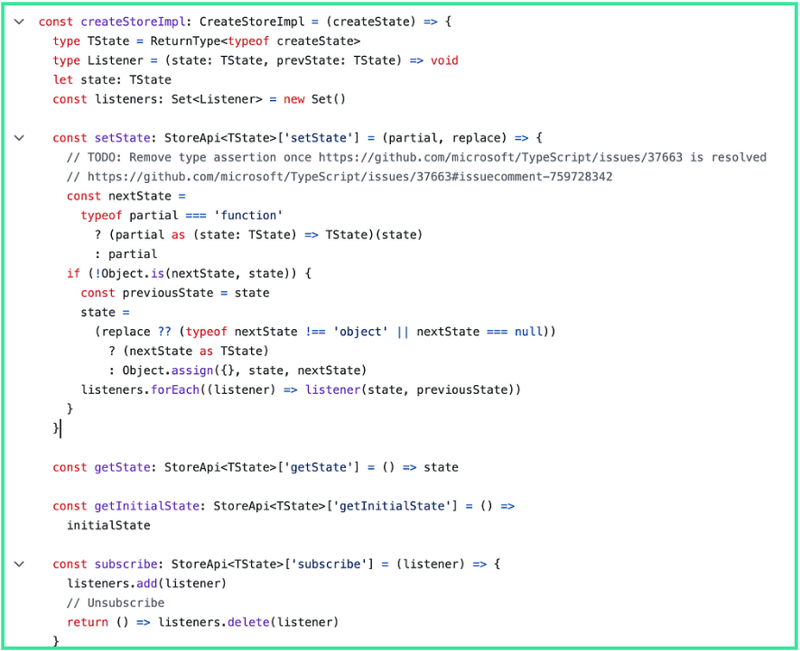
createStore is exported from vanilla.ts and you will find this at the end of the file.
export const createStore = ((createState) => createState ? createStoreImpl(createState) : createStoreImpl) as CreateStore
createStore is arrow function that accepts a parameter called createState. if createState exists, createStoreImpl(createState) is called.
createStoreImpl
const createStoreImpl: CreateStoreImpl = (createState) => {
type TState = ReturnType<typeof createState>
type Listener = (state: TState, prevState: TState) => void
let state: TState
const listeners: Set<Listener> = new Set()
const setState: StoreApi<TState>['setState'] = (partial, replace) => {
// TODO: Remove type assertion once https://github.com/microsoft/TypeScript/issues/37663 is resolved
// https://github.com/microsoft/TypeScript/issues/37663#issuecomment-759728342
const nextState =
typeof partial === 'function'
? (partial as (state: TState) => TState)(state)
: partial
if (!Object.is(nextState, state)) {
const previousState = state
state =
(replace ?? (typeof nextState !== 'object' || nextState === null))
? (nextState as TState)
: Object.assign({}, state, nextState)
listeners.forEach((listener) => listener(state, previousState))
}
}
const getState: StoreApi<TState>['getState'] = () => state
const getInitialState: StoreApi<TState>['getInitialState'] = () =>
initialState
const subscribe: StoreApi<TState>['subscribe'] = (listener) => {
listeners.add(listener)
// Unsubscribe
return () => listeners.delete(listener)
}
const api = { setState, getState, getInitialState, subscribe }
const initialState = (state = createState(setState, getState, api))
return api as any
}
In our previous articles, I have written about how setState, subscribe work. We will cover the remaining functions such as getState, getInitialState, createState.
getState
getState simply returns the state that is declared at the top of this createStoreImpl function.
const getState: StoreApi<TState>['getState'] = () => state
getInitialState
getInitialState returns the initialState.
const getInitialState: StoreApi<TState>['getInitialState'] = () =>
initialState
createState
createState is used to initialise the state variable.
const createStoreImpl: CreateStoreImpl = (createState) => {
createState is a parameter in createStoreImpl. Let’s run some experiments using the demo example provided in the Zustand’s repo.
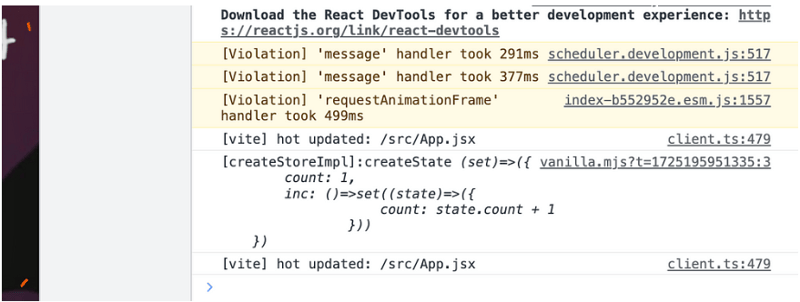
This is basically just what you pass into “create”
// Create the store using Zustand
const useStore = create((set) => ({
count: 1,
inc: () => set((state) => ({ count: state.count + 1 })),
}));
State initialisation happens in vanilla.ts at L93, even though create is originally exported from React, react.ts internally calls createStore in vanilla.ts.
So how does calling createState initializes the state?
const initialState = (state = createState(setState, getState, api))
The trick lies in calling the arrow function, createState. From the above code snippet, you can see that createState is called with setState, getState, api
Let’s run some experiments with this information. Let’s pass a custom function named test as the parameter without the original parameters.
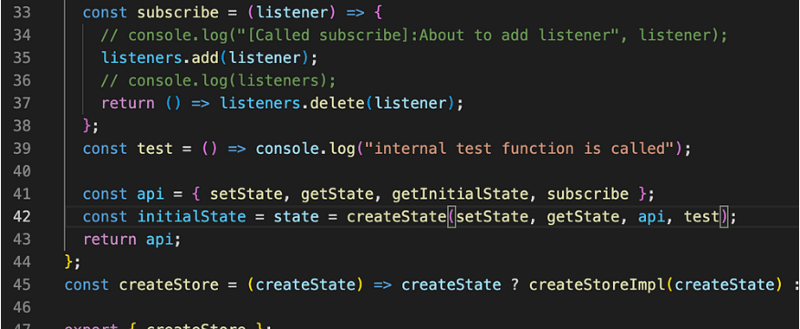
The above image shows the custom test function I added to demonstrate how the parameters are passed to createState function.
let’s now see this internal test function in action. For us to access this test function, the following example shows how createStore can be initialised with this newly added test parameter.
// Create the store using Zustand
const useStore = create((set, get, api, test) => ({
count: 1,
inc: () => set((state) => ({ count: state.count + 1 })),
test: () => test()
}));
Because we exposed test in vanilla.mjs as shown below, you will have access to this function when you initialise the create function
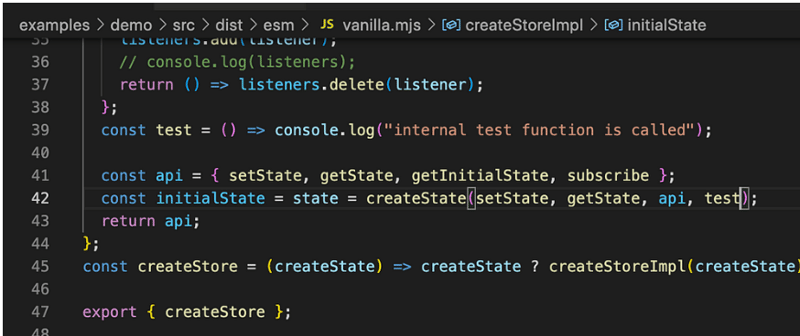
I am triggering this test function when the button in the demo example is clicked.
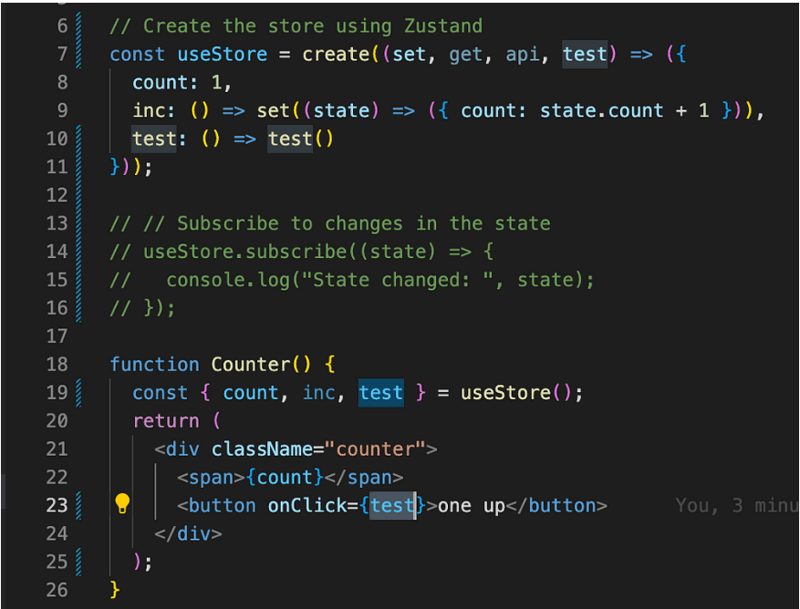
This, in turn, calls the test function.
This is some advanced JavaScript arrow functions usage and oh, we also just added a custom test function and used in the demo app. That is cool.
About us:
At Think Throo, we are on a mission to teach the best practices inspired by open-source projects.
10x your coding skills by practising advanced architectural concepts in Next.js/React, learn the best practices and build production-grade projects.
We are open source — https://github.com/thinkthroo/thinkthroo (Do give us a star!)
Looking to build bespoke web systems for your business? Contact us at hello@thinkthroo.com
About the author:
Hey, I’m Ram. I am a passionate software engineer/OSS Tinkerer.
Checkout my website: https://www.ramunarasinga.com/
References:
- https://github.com/pmndrs/zustand/blob/main/src/vanilla.ts#L97
The above is the detailed content of createStore in state's source code explained.. For more information, please follow other related articles on the PHP Chinese website!

Hot AI Tools

Undresser.AI Undress
AI-powered app for creating realistic nude photos

AI Clothes Remover
Online AI tool for removing clothes from photos.

Undress AI Tool
Undress images for free

Clothoff.io
AI clothes remover

Video Face Swap
Swap faces in any video effortlessly with our completely free AI face swap tool!

Hot Article

Hot Tools

Notepad++7.3.1
Easy-to-use and free code editor

SublimeText3 Chinese version
Chinese version, very easy to use

Zend Studio 13.0.1
Powerful PHP integrated development environment

Dreamweaver CS6
Visual web development tools

SublimeText3 Mac version
God-level code editing software (SublimeText3)

Hot Topics
 What should I do if I encounter garbled code printing for front-end thermal paper receipts?
Apr 04, 2025 pm 02:42 PM
What should I do if I encounter garbled code printing for front-end thermal paper receipts?
Apr 04, 2025 pm 02:42 PM
Frequently Asked Questions and Solutions for Front-end Thermal Paper Ticket Printing In Front-end Development, Ticket Printing is a common requirement. However, many developers are implementing...
 Demystifying JavaScript: What It Does and Why It Matters
Apr 09, 2025 am 12:07 AM
Demystifying JavaScript: What It Does and Why It Matters
Apr 09, 2025 am 12:07 AM
JavaScript is the cornerstone of modern web development, and its main functions include event-driven programming, dynamic content generation and asynchronous programming. 1) Event-driven programming allows web pages to change dynamically according to user operations. 2) Dynamic content generation allows page content to be adjusted according to conditions. 3) Asynchronous programming ensures that the user interface is not blocked. JavaScript is widely used in web interaction, single-page application and server-side development, greatly improving the flexibility of user experience and cross-platform development.
 Who gets paid more Python or JavaScript?
Apr 04, 2025 am 12:09 AM
Who gets paid more Python or JavaScript?
Apr 04, 2025 am 12:09 AM
There is no absolute salary for Python and JavaScript developers, depending on skills and industry needs. 1. Python may be paid more in data science and machine learning. 2. JavaScript has great demand in front-end and full-stack development, and its salary is also considerable. 3. Influencing factors include experience, geographical location, company size and specific skills.
 How to achieve parallax scrolling and element animation effects, like Shiseido's official website?
or:
How can we achieve the animation effect accompanied by page scrolling like Shiseido's official website?
Apr 04, 2025 pm 05:36 PM
How to achieve parallax scrolling and element animation effects, like Shiseido's official website?
or:
How can we achieve the animation effect accompanied by page scrolling like Shiseido's official website?
Apr 04, 2025 pm 05:36 PM
Discussion on the realization of parallax scrolling and element animation effects in this article will explore how to achieve similar to Shiseido official website (https://www.shiseido.co.jp/sb/wonderland/)...
 Is JavaScript hard to learn?
Apr 03, 2025 am 12:20 AM
Is JavaScript hard to learn?
Apr 03, 2025 am 12:20 AM
Learning JavaScript is not difficult, but it is challenging. 1) Understand basic concepts such as variables, data types, functions, etc. 2) Master asynchronous programming and implement it through event loops. 3) Use DOM operations and Promise to handle asynchronous requests. 4) Avoid common mistakes and use debugging techniques. 5) Optimize performance and follow best practices.
 The Evolution of JavaScript: Current Trends and Future Prospects
Apr 10, 2025 am 09:33 AM
The Evolution of JavaScript: Current Trends and Future Prospects
Apr 10, 2025 am 09:33 AM
The latest trends in JavaScript include the rise of TypeScript, the popularity of modern frameworks and libraries, and the application of WebAssembly. Future prospects cover more powerful type systems, the development of server-side JavaScript, the expansion of artificial intelligence and machine learning, and the potential of IoT and edge computing.
 How to merge array elements with the same ID into one object using JavaScript?
Apr 04, 2025 pm 05:09 PM
How to merge array elements with the same ID into one object using JavaScript?
Apr 04, 2025 pm 05:09 PM
How to merge array elements with the same ID into one object in JavaScript? When processing data, we often encounter the need to have the same ID...
 How to implement panel drag and drop adjustment function similar to VSCode in front-end development?
Apr 04, 2025 pm 02:06 PM
How to implement panel drag and drop adjustment function similar to VSCode in front-end development?
Apr 04, 2025 pm 02:06 PM
Explore the implementation of panel drag and drop adjustment function similar to VSCode in the front-end. In front-end development, how to implement VSCode similar to VSCode...






